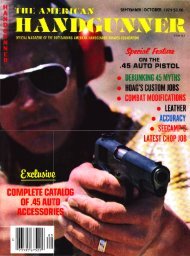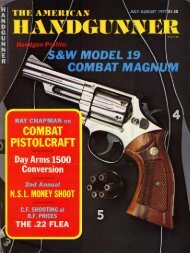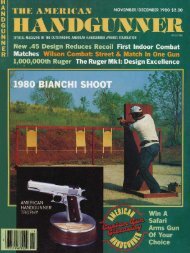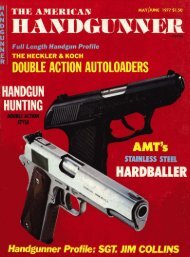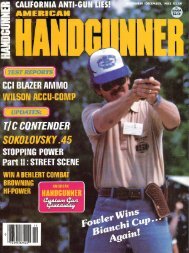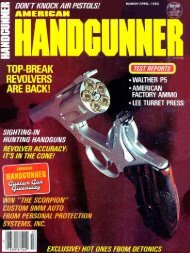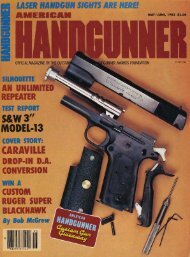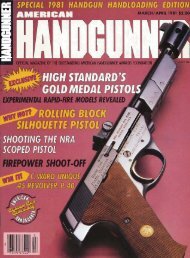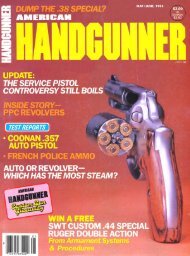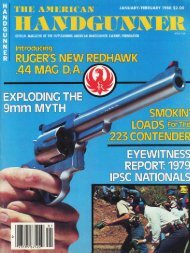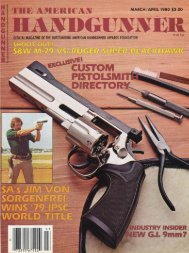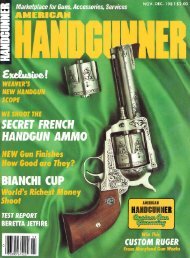PoRk. COPTALKCOMBAT STANCES FOR POLICEecades, <strong>American</strong> police and defense-mindedcivilians have beentaught that in a close-quarters firefight, itwas best to shoot "from the hip," and theonly real debate was the "FBI Crouch"versus the Bill Jordan school of "don'tmove anything but your gun-hand.Lately, however, serious thinkers havecome to accept the idea of using bothhands and eye-level aim even at ranges ofseven yards and less. This approachmakes mucho sense.As a policeman and a combat weaponsinstructor, I have had the opportunity tointerview and tape record a large numberof cops and troopers who have survivedshootouts. Most of them were trained toshoot from the hip, crouching or other-Turret stance is favored for accuracy by PPC shooters.Shown is John DeChellis, National Champion in 1974.wise, at close-range; training tells, andmost of them did the same under pressure.The result was that, time and again,they would utter the phrase: "I can'tunderstand how I missed him that close."Most of them were relatively goodshots. Many of them were interviewed byme only after they had recuperated fromgun and knife wounds. Typical was themetro patrolman who wore an honestlyearned Expert badge and missed threeshots from the hip at his assailant, at arange of three and a half feet! His assailant,however, had raised his gun, takena quick aim, and shot the officer an inchto the side of his heart. I play the tape recordingof that officer's remembrances tomy ~olice classes, and they never fail toshudder when he tells of the aftermath ofthis close encounter.Clearly, hip-shooting doesn't work terriblywell in real life. It's great on the firingrange, when the target is a paper silhouettethat obligingly stands still for you, andwhen you have time to get your feetplanted and your body indexed to the targetwhile the rangemaster is droning hiscommands. But it doesn't work on thestreet because, without your feet plantedjust so and without sights, there is no wayto index your aim at your opponent! Ifyou must turn offcenter to fire, the gunnow swings at the end of a pendulum thatis your arm, a pendulum loose on threejoints (shoulder, elbow, wrist), and themuzzle will probably go by him before youfire.Jeff coder and his free-style combatshooting disciplines proved as early as the1950's that the difference in speed betweena one-hand hipshot and a two-handroughly aimed one, could be measured inmilliseconds. Yet the hit percentage isenormously increased.Though hip shooting at seven years andless is still taught to most of our police,forward-thinking instructors generally realizethat it is obsolete. Even the Smith &Wesson Academy with its advanced butFBI-influenced methods, now permits studentsto bring the gun up to chest level atclose range, where the gun can be visuallyindexed in the periphery of the shooter'svision.The real choice in a combat stance is nolonger one hand versus two; it is theWeaver stance versus what Col. Coopercalls the "Fairbairn Isosceles" position,which I prefer to recognize as the "McGeeTurret" stance.Contrary to common belief amonghandgunners, the Weaver stance is notmerely a two handed hold. Properlyexecuted, one stands with the feet about18 inches apart, with the foot on the nongunhand-sideslightly forward. The elbowof the supporting hand is sharply bent tocreate a springy recoil-absorber effect.The gunhand pushes the pistol forwardinto the support hand, which pushed backagainst it, both with about forty poundspressure. The elbow of the gun arm is.Â¥. .AMERICAN HANDGUNNER * MAY/JUNE <strong>1978</strong>* .
Ibent in the "pure" Weaver stance, thoughCooper's highest-achieving student, formerWorld Champion Ray Chapman, prefersto lock the elbow of his shooting arm.While not quite as precise in slow-fireaccuracy as the locked-wrists-and-elbowsof the PPC competition shooter, theWeaver stance does permit more accuraterapid fire with a full-power gun, due tothat shock absorber effect of the bent elbows,and the forward-and-backward pressureexerted on the grip.The McGee Turret position pays nogreat attention to foot position, on thetheory that when you go for your gun inthe face of imminent danger, you don'thave time to do a quick dance-step andget into position. The elbows are locked,with the arms straight out, at eye level orslightly below. The entire torso locks rigidly,in effect becoming a gun turret thatpivots at the hips. While Fairbairn mayhave been the first to put this method intoa manual, the man who popularized it inthe United States was Lt. Frank McGee,head of the NYCPD Firearms Section.Frank had analyzed thousands of gunfights,and come to the same conclusionthat I and others arrived at later: hipshootingdidn't work, and the best chance for aquick, instant hit was a swiftly-taken twohand hold at eye level.An advantage of the turret position isthat it works quite well even when urgencyor darkness prevent you from seeing yoursights. With the arms locked in front ofyou in an isosceles triangle, and your upperbody muscles rigidly tense, your headturns where your eyes look, and the gunautomatically follows. If there really issuch a thing as "instinct shooting," theMcGee stance achieves it most effectively.It is also easier to learn and train with.The Weaver stance, though highly effectivefor a committed shooter who practicesheavily, won't be quite natural forsomeone who only qualifies a couple oftimes a year. The exact alignment of thebent arms is something that the individualwill have to fumble for. But thrusting thearms all the way out in front and lockingthem is quick, easy, natural.While the top free-style shooters favorthe Weaver stance, most of the ace PPCshooters use the locked-elbow turret position,even though no part of their courserequires them to face an off-center target.There are, however, some notable exceptions.Record setting police combatshooters like Jim Cirillo and Frankie <strong>May</strong>both bend their elbows slightly whenshooting, though their arm contours areparallel to each other, not asymmetrical asin the Weaver stance.It is significant that the free-style shooters,who are going mainly for time, useWeaver's brainchild, while the PPC shooters,who are holding unhurriedly on the X-ring, by and large favor the isosceles hold.The first is better for fast shooting of hardkicking guns, and the second is moresteady and precise. What puts me in favorAMERICAN HANDGUNNER, of the latter for police and civilian self defensetraining is that it is more natural andeasy to learn, and probably more effectivein darkness.Either is vastly superior to shootingfrom the hip in either the FBI or the Jordanstyle. It worked for Bill because he wasand is a superb and highly practiced shot,who by dint of his experience and his superbreflexes and coordination learned tomake a bullet go where he wanted it towithout really indexing his body, his feet,or his gunsights. Few of us can learn to"think a bullet home" in the same manner.The FBI crouch, modified to bothhands,eye-level or point-shoulder shooting,still has its good points. Many peoplefind that the crouch somehow lets themget the gun up and "on" quicker, myselfincluded, and many find that it balancesthem better. Standing straight up with a.45 or a Magnum at the end of your arms,it is entirely possible to be pushed slightlyoff-balance by the recoil, especially ifyou're standing on an uneven surface.Real-life shootouts oft unfold in ice-coveredalleyways and sidewalks, and on tene-ment staircases, and a rookie who hasnever shot anyplace but a paved firingrange may learn the hard way that balanceis more important than anyone told him.IWeaver Stance or McGee Turret? Thechoice is yours, but predicate that decisionon what's most natural for you. Trythem both, extensively, on surprise targetsat different angles, and not just plantingyour feet and facing down range. Each hasits good points and bad. And either willprobably save your life more effectivelythan a "shot from the hip" when the chipshit the table quick and a fast hit is youronly hopeof survival.El DORADO$~~ÃTop quality cowhidw, s t d reinforced, toft leathermed. SPECIFY: nome 6 model of gun, caliber, bandlmgth. ACTUAL lirawr.mmt wh-r. worn. Choice of Plain,iikttweav, or Floral.. . Black. Brawn or Natural color.Return in 10 days for dund if not satisfied (when ordering''add 11.75 for ihinnmo . . Colil. Re,. odd 6% Sçlà Toul--- --COMBAT PISTOL WORKThe finest custom work on all handguns.Action work, throating, spe-cial sights, hard chrome. Send1SASE for orice list. LAWRENCE &FOR SHOOTERS!Rugged new lens gives you unparalleled clarity,yet is virtually unbreakable and won't scratch*!ooting optics industry, are %ht of glass, resist scratching,and- are viftually unbreakable. Semi-distortion free glasses.Available in six colors withnanasome reinforced carrying case.Dealers inquire.ruction eliminates glareend frad interference. High reliefa ym of Sight Savingadjustable bridge keeps. Plastic tipped earpiecesable, secure fit.- Wftether ribu're a target, benchrest, porting Opticser, law enforce- 842 Broadway, mpt. AH^ter, you'll shoot New York, New York 10003WUer, safer,



